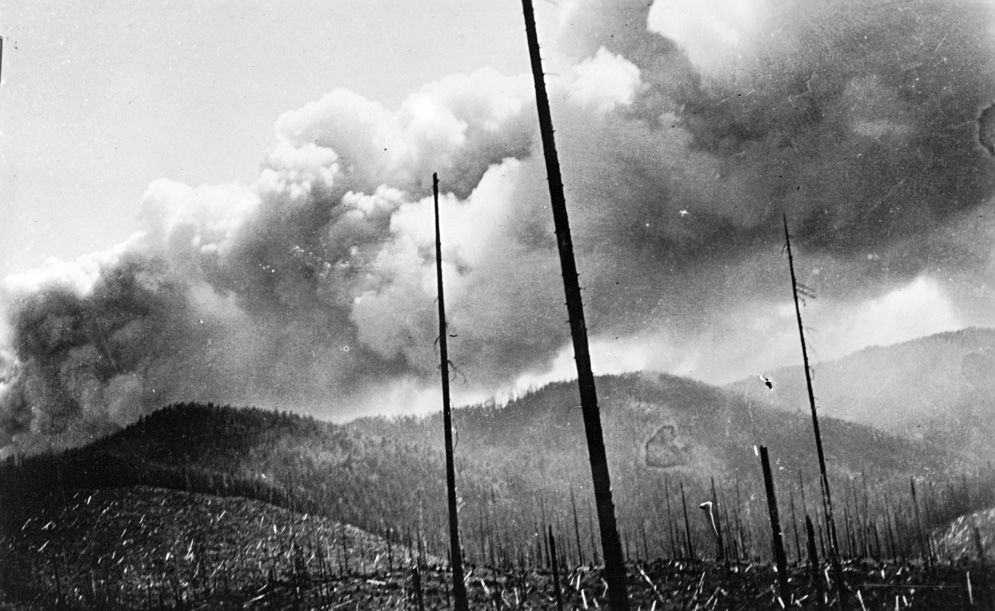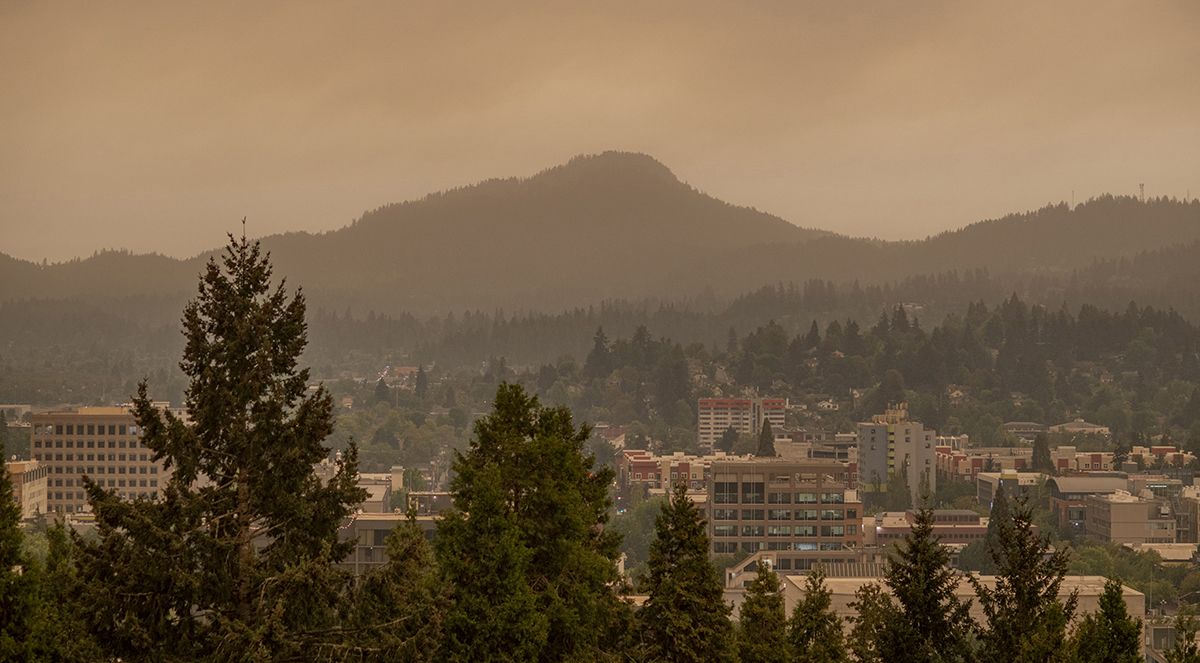UO faculty discuss the challenge of reducing wildfire risk and helping protect the public
Story by Mark Furman
July 16, 2025
Forest scientist James Johnston framed the topic of wildfires with a quote from The Oregonian newspaper.
"Much of the sickness which prevails among us at present is attributed to the heated state of the atmosphere and the immense volumes of smoke ever created by the vast fires," the University of Oregon assistant research professor read from a past edition.
And the date on that story? Sept. 10, 1864.
Wildfires are not new in Western Oregon, and humans have been feeling their effects for generations. But as climate change stokes larger and more devastating fires across the West, the challenge is becoming increasingly urgent.

Johnston studies fire ecology and restoration policy at the Institute for Resilient Organizations, Communities and Environments at the University of Oregon. He and other members of the UO faculty whose research involves wildfire and smoke took part in a UO-hosted forum for journalists on opportunities, and challenges, related to communicating with the public about fire prevention and response.
Wildfire smoke poses public health issue
Public health experts say wildfire smoke contains many tiny particulates that are hazardous to human health. That makes it easy to identify who's at risk from wildfire smoke, said science communication expert Ellen Peters, "because it's everybody."
Peters leads the Center for Science Communication Research at the School of Journalism and Communication. The center has conducted research on public smoke warnings and how the public perceives the danger from wildfire-related air pollution.
But wildfire smoke doesn't affect everyone in the same ways.
"Children, pregnant people, people who have existing conditions - things like respiratory and cardiovascular conditions - they're all at more risk than the general population," Peters said.
Journalists and other public communicators can help parents and caretakers recognize the risk and then know how to act to reduce the hazard to children, she said.
"A lot of parents are unaware of these health risks of wildfire smoke, or they don't know how to protect their children, or they just don't take the risks all that seriously," Peters said.
In past research, Peters and her team also found that only 75 percent of people surveyed knew where to find information about air quality. And even parents who know how to access air quality data may not understand how to interpret those numbers.
Journalists can help close that gap, Peters said.
Many experts say that protecting your family and neighbors starts with knowing where to find information about wildfire smoke and air quality.
Turning off electricity to prevent fires creates new challenges
But the disruptions to people's lives can begin before a fire even breaks out, said Amanda Stasiewicz, assistant professor of environmental studies in the UO's College of Arts and Sciences.
Stasiewicz studies public safety power shutoffs, where electric companies de-energize lines to avoid causing a wildfire during high fire danger days. The idea largely originated in California after the 2017 and 2019 fire seasons, she said, when half or more of the acres burned in the state were related to electrical infrastructure failure.
Image captions

"There's this precedent for concern for electrical utilities that are operating in fire-prone spaces," Stasiewicz said. "And the question becomes, do we de-energize or not? And in part, the reason we might not want to de-energize has to do with the impacts it's going to have on communities, particularly in rural America."
The challenge: Turning off the power to avoid starting a fire can also disrupt anything else that requires electricity, like emergency alerts. Stasiewicz noted that local farmers and ranchers are sometimes the first responders to a fire.
"They're on their own to protect the crops, the rangelands or their homes," Stasiewicz said.
In such cases, turning off electricity would cut power to electric water pumps that could help them slow fires before emergency responders can show up.
And even if flames aren't directly threatening your home, losing power can make it difficult to cope with multiple hazards at once, such as extreme heat and air pollution from wildfire smoke. Without electricity, people can't run air conditioners or air filters in their homes.
The loss of power could also affect people who use medical devices or refrigerate critical medications, Stasiewicz added.
Prescribed fire reduces fuels but still causes smoke
The way forests are managed can affect their risk for catastrophic fires. For instance, forest managers might thin forests by selectively removing some trees and then do a low-intensity prescribed burn. That can burn up flammable materials under controlled conditions, making it less likely that a stray spark from a truck tire will ignite a megablaze.
But the limiting factor in these fuel-reduction projects is often the skill and capacity of the fire management workforce, said Johnston, the fire scientist.
"A well-trained crew or leader is far superior and can do much more efficient work than new people," he said.
Johnston hopes to see fire agencies support a highly trained workforce that has the capacity to do such work at the scale it's needed.
But even prescribed burns put smoke into the atmosphere, and sometimes into nearby communities.
"With prescribed fire, there is the ability to plan for the smoke, so you will know when the burns are happening and what communities it's likely to affect," said Heidi Huber-Stearns, director of the Center for Wildfire Smoke Research and Practice at the UO.
Huber-Stearns pointed to the West Bend Prescribed Fire Pilot Project in Oregon's Deschutes County as an example. Working with the community to manage smoke impacts, the Deschutes National Forest was able to use fire on a much larger scale than in the past, she said.
"The Deschutes National Forest was able to burn seven times the amount they had generally been burning within the forest in a wildland urban area." Huber-Stearns said. "At the same time, public health partners were able to increase their outreach to different populations to help them plan and prepare for the smoke events."






